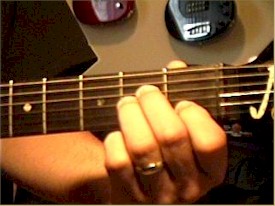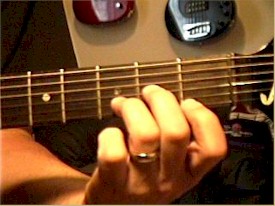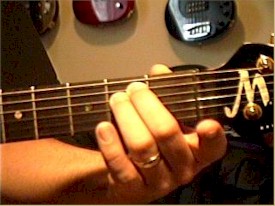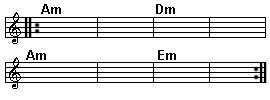Scroll through the lesson and click on notation/video/audio links to load the interactive players.
Please subscribe to get full access to all lessons for only $7.95/month PLUS 1 week free trial.

Riff Interactive lessons are
LESS expensive and
MORE interactive than alternatives!
More Info
|
|

Beginning Guitar II
- Lesson 4
Your First Minor Chords
check your
tuning
Support: software tip: you can select one note in
the tuning at a time and loop it
Lyle: In
the last lesson I introduced the 5 basic open chords. They where the plain major
chords in the open position. This lesson will show you the three basic minor
chords that are in the open position, Am, Dm, and Em, then teach you to use them
in a jam progression.
Lyle: Let's start with the A minor (Am)
chord:
Am
chord
Am

Lyle: The circled notes in the TAB file are the
root notes, A. Now try strumming the chord like this:
Am strum
pattern 1
Am strum pattern
1
Lyle:
Next is the D minor (Dm) chord. The open 4th string is the D string which will
be your root note or bass note for this chord:
Dm

Dm chord
Lyle:
Make sure all the right notes are ringing clearly. For chords like these
you will have to use the finger tips. If you have large fingers, you may need to
search for a guitar with a wide neck. Now try strumming the Dm chord like
this:
Dm strum
pattern 1
Dm strum pattern
1
david: Are
there certain styles or kinds of styles of songs that you shouldn't try to play
on an acoustic guitar? Or can it always be 'translated'?
Lyle: david, almost any style of music can be
played on electric or acoustic. Heavy metal style might not come across very
good on acoustic though.
Lyle: The third chord for you to learn is one of
my all time favorite chords, the open position Em:
Em

Em chord
Lyle:
For some reason, this chord always sounds bluesy, or like a chord from a Pink
Floyd song.
Lyle: Make sure you use two fingers to play the
Em chord, and use your finger tips. Use your second and third fingers to play
the Em chord. Now try strumming the Em chord like
this:
Em strum
pattern 1
Em strum pattern
1
Lyle:
Let's review the three new minor chords.
Lyle:
First, look at how each of them compare with the major version of the chords you
learn in the last lesson. Here's A and Am, notice what is changed or different
between them:
A
and Am
Lyle: In
musical theory terms, the major 3rd degree of the major chord is flatted to a
minor 3rd to produce a minor chord.
Lyle: Let's compare the D major chord to the D
minor chord:
D and
Dm
Lyle:
Notice the sound difference between the major and minor chords. Major chords
sound strong, minor chords sound soft. Compare the E major and
Em:
E and
Em
Lyle:
Ok, now I would like you to learn this simple and short chord progression using
the three minor chords you just learned:
Lyle: Here's what the chord chart for the
progression will look like:
chord chart

Lyle: Here's how I want you to play it using the
strum patterns you learned earlier for each chord:
Full
progression
Full
progression
Lyle:
Your goal for this lesson is to be able to play that strumming pattern for those
chords, follow the chord chart and progression, and be able to play right along
to this looping jam track:
Jam Track in Am
Lyle: This is a good place to take a break.
Practice these over and over, then move on to the next lesson!
|
<< load notation from left
|
|
<< load audio from left
|
<< load audio from left
|